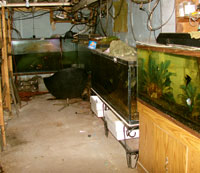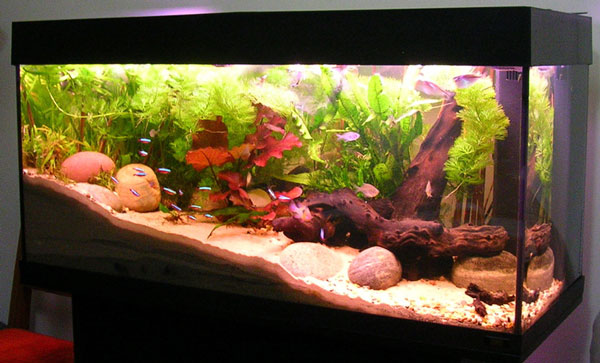
If you are a member of a fish club, look around the room the next time you go to one of your meetings. What types of people make up the majority of your membership? Are they middle-aged? Are they mostly men? A few wives? The children of regular attending members? Where is the future of the hobby? What does your club do to draw the attention of potential members?
Our club meetings are filled with all of the above, but mostly familiar faces — the same ones I have seen off and on for the last six or seven years. Honestly, most of the long-standing members of our fish club have outlived most of the species that we keep, whether it be the 12-year-old discus or the 20-year-old rainbowfish. On the other end of the spectrum, there are members or meeting visitors who have the life span or cycle of the killifish: They’re there for a year and gone, or are dormant for a long time and resurface through the years at an occasional meeting or auction.
I have attended monthly meetings of the Greater Cincinnati Aquarium Society (GCAS) for a little over six years. I have kept fish for longer than twice that amount of time. I consider myself an "average” club member. I attend meetings, work at the auctions, turn in plants or fry for points toward awards, and I always try to go to the Christmas Banquet. I have never been the speaker at a meeting, or stepped up to run for an officer position or to chair a committee because I always felt I was either too busy or not qualified. I don’t know how some members do all the things for the club that they do.
Well, that all changed when Phil Benes, our club vice president and longtime ACA Board Member mentioned something at our meeting about what we could do as a club to sustain the future of the hobby. The success rate of new membership is very low. Many people give up after that first tank or first die-off. Tanks get sold, given away and thrown out in the weekly garbage collection. So, Phil sparked an idea of how I could get more young people interested in the hobby.
I’d already been trying to keep kids in the hobby through the 20-gallon-long fish tank I keep in my room at R. A. Jones Middle School in Florence, Kentucky. Each year, I pick one or two species to concentrate on and breed in my eighth-grade social studies classroom. One year, it was yellow makriff guppies, the next year yellow labs, then brichardi — but always something that excites the kids with fry. I have students on a waiting list to take fish home all year long. I only have a few requirements:
This has been a successful venture to a point — it only benefitted the students who already had a fish tank at home. There had to be another outlet for the ones who wanted to join in the excitement but were limited due to lack of resources.
Every 20 days at my school, we give attendance incentives to the students in contest form. The first-period class with the highest attendance may get doughnuts; or the seventh-period class with the highest attendance for the period may get to go outside and have popcorn or an ice cream on the ballfield. I wanted to add to that.
The plan was to give away fish and a tank setup for each attendance period. The parents would have to give permission (though no parent has said no) for their child to take a tank home. The students could take the tank setups home if a parent picked them up, or, with permission, I could drop it off and help them set it up. I thought the best way to give tanks away was through a drawing. In keeping with the theme of fish and attendance, I named the program, "Stay in Schools.” I just needed club approval, funding and a sponsor for supplies. I e-mailed our society’s vice president, Phil, for help.
Phil and I talked back and forth between e-mails and phone calls, and started putting the pieces together. I posted a few information links in the forums of our club website and was overwhelmed with the feedback from members. I had responses from members who wanted to donate fish, old magazines, supplies, used tanks, foods and dry goods. It was exciting, and it looked like this was going to happen after all.
I started to talk to local fish stores to get a sponsor that would work with the club to help us pull this venture off. I talked with Bill and Larry at World of Pets in Florence, Kentucky, whom I’ve known for 15 years. Bill and Larry made us a deal on some tank setups, selling us tanks, lids, lights, gravel, filters and heaters at cost. I purchased the first two setups to get the program started. I planned on giving away eight to nine setups a school year.
Next, I started designing a certificate. I made nine in all, each one numbered. They have our club name (Greater Cincinnati Aquarium Society), Bill’s store (World of Pets) and my school’s name on them. I even did a little cut-and-paste to add a picture of an aquarium with a boy and girl watching the fish. Each certificate requires three signatures to be valid, one from GCAS, one from a World of Pets’ representative and one from administration in my school. Bill has an example of one hanging in his store, and I keep one hanging in my classroom on the front chalkboard.
The program was underway, but it was not official yet. Because I still needed club approval, I briefed the members on my proposal before putting it to a vote. After laying out what I had already done with Phil’s help, members debated and supported my efforts. More donations were offered from club members. The motion was put to vote and overwhelmingly passed. Money was allocated to sponsor the "Stay in Schools” program as a pilot program with my school for one year.
School started, and after 20 days passed, it was time to draw a winner. I had been promoting our "Stay in Schools” program in all of my classes and had the principal put it on the announcements.
Rachael, our first winner, was a sixth-grader at R. A. Jones. She was so excited when her name was announced over the morning announcements. I went to visit her during my planning period that morning. I keep one complete setup in my room, so students can see what they may win. I congratulated her and gave her a couple of fish magazines from my room, copies of websites for help setting up tanks and acclimating fish, information on our fish club, an old newsletter and a certificate that they can turn in to Bill at the pet store for a complete tank setup at no charge. Rachael can go online to our forum for information, and ehe can have fish from me and can buy fish from Bill, and she went home very happy. I called her mom after school; she told me how excited Rachael was when she ran through the door after school. The Greater Cincinnati Aquarium Society would like to congratulate the winners of the 2007 to 2008 "Stay in School Program.” They were as follows: Rachael B., Denzel C., Tabitha C., Destiny S., Tiara J., Justin T., Sara M. and Kim C. Winners from 2008 to 2009 are Zack S., Emily G., Emrah K, Haylee S., Joel F. Sahra S. and Seth S.
I have interviewed several of the students with a questionnaire months after their win, and they are still thrilled with the addition to their house. A couple of the parents even commented on how peaceful it was to just come home and sit down and watch the fish for a while. I have helped introduce these students and their families to the hobby, and hopefully they will stay in it. The "Stay in Schools” program may help sustain the life of the hobby — there are many more tanks and many more winners in the years to come.
Where will it go from here? I would like to continue this program every year and expand it; there are other members of the club affiliated with the school system or youth programs. We can only hope it will grow and that it can influence others to do something similar in their own clubs and schools.
 Modular LED lighting for freshwater and marine aquariums
Aquarium manufacturers are shifting to LED lighting systems
Modular LED lighting for freshwater and marine aquariums
Aquarium manufacturers are shifting to LED lighting systems
 Proper Aquarium Lighting for your Aquarium Application
Lighting, just like filtration and heating, is an essential
Proper Aquarium Lighting for your Aquarium Application
Lighting, just like filtration and heating, is an essential
 Fish Aquarium Setup Decorations
Few things are as captivating as a beautifully decorated aqu
Fish Aquarium Setup Decorations
Few things are as captivating as a beautifully decorated aqu
 Custom Aquarium Setup
I wonder, is your setup like mine? The answer is proba
Custom Aquarium Setup
I wonder, is your setup like mine? The answer is proba
 Freshwater Aquarium Beginners Guide
Aquariums are beautiful additions to virtually any living ar
Freshwater Aquarium Beginners Guide
Aquariums are beautiful additions to virtually any living ar
Copyright © 2005-2016 Pet Information All Rights Reserved
Contact us: www162date@outlook.com